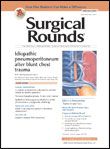Transcatheter Aortic-Valve Replacement Deemed Safer than Open-Heart Surgery
Researchers believe the less-invasive nature of transcatheter aortic-valve replacement systems allows patients to mobilize and recover in as little as one week, which contributes to the device's greater survival benefit compared to open-heart surgery.

Until recently, repairing aged or diseased aortic valves required open-heart surgery and valve replacement with an artificial piece. Unfortunately, many patients who need valve replacement are considered inoperable or high risk, as they are too sick or frail to undergo the traditional operation and its lengthy recuperation period.
considered high risk for standard valve replacement surgery
In November 2011, the US Food and Drug Administration (FDA) approved a transcatheter aortic-valve replacement (TAVR) system called the Sapien Transcatheter Heart Value for aortic stenosis patients who are . This TAVR is constructed of cow tissue and polyester and supported with a stainless steel mesh frame. It is inserted using a delivery catheter via a 1-inch cut in a leg artery, through which the surgeon guides the catheter to the heart and places the device inside the dysfunctional valve.
The approval was based on a study of 365 patients who received the Sapien valve. Although those patients were 2.5 times more likely to experience a stroke and had 8 times as many vascular and bleeding complications than the control group, 69% of the Sapien patients were alive at one year compared to 50% of control patients. Currently, the system’s manufacturer, Edwards Lifesciences Inc., is conducting additional studies with next-generation devices.
On January 17, 2014, the FDA approved a similar TAVR device, Medtronic Inc.'s CoreValve, for patients who are unable to undergo aortic-valve surgery. Its approval was based on the CoreValve Extreme Risk trial, a study of patients who could not have conventional aortic-valve replacement surgery due to risk factors that increased mortality risk to 15% or more. At one year, 75% of patients were alive, while 25.5% of patients had died or experienced a major stroke — a rate approximately 40% lower than the FDA-identified acceptable rate. More than 20% of patients needed pacemaker implantation after surgery. This TAVR system was associated with very low stroke and paravalvular leak rates.
At the 2014 American College of Cardiology (ACC) scientific meeting, held March 29-31, 2014, in Washington, DC, researchers presented a new study on the CoreValue TAVR system, which appeared online in the New England Journal of Medicine. Across 55 surgical centers, they enrolled 795 patients with severe aortic stenosis at increased surgical risk and randomly assigned them to either TAVR (n=394) or surgical aortic-valve replacement (n=401). The primary endpoint was death from any cause at one year.
At one year, the all-cause death rate was significantly lower in the TAVR group than the surgical group. Additionally, patients in the TAVR group had an absolute risk reduction of 4.9%. The researchers believed the TAVR’s less-invasive nature allows patients to mobilize and recover in as little as one week, which contributes to the survival benefit that occurred consistently across 9 subgroups, including age, sex, body mass index (BMI), hypertension, previous coronary artery bypass grafting (CABG), peripheral vascular disease, and diabetes.
Although the study was not designed to gauge stroke outcomes, the stroke rates were 13% and 9% in the surgery and TAVR groups, respectively.
The researchers concluded both TAVR systems will require long-term study to determine whether TAVR valves endure as long as those implanted surgically, which last around 20 years.
